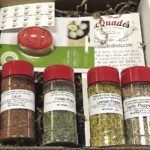As the legend goes, the Christmas Pickle is an old German custom that started with parents hiding a pickle-shaped green ornament deep in the boughs of the Christmas tree after the children had gone to bed on Christmas Eve. Then on Christmas morning before presents were opened, the children would search for that hidden pickle on the tree and whoever found it first, would get an extra gift. (One flaw with this German tradition story is that children in Germany open gifts on Christmas Eve, not Christmas Day.)
I saw my first Christmas Pickle a few weeks ago during a visit to the Christmas Wonderland displays at Thunder Bay’s Victoria Cupboard, where I spotted a small tree with shiny green pickle ornaments hanging from its branches. A pickle on a tree? Then I read the accompanying tag about the legend of the German Christmas Pickle.
Until then, I had never heard of this Christmas Pickle tradition from Germany….and neither, it seems, had the Germans until they learned about it from Americans, where the custom has become quite popular.
Journalist Alexandra Churchill wrote in her 2014 article, “The Untold Story of the Christmas Pickle Ornament” in Martha Stewart Living, “All I can say for certain is that to this day almost no one in Germany has ever heard of the German Christmas pickle custom. So far I have found no historical or other evidence to indicate that the Weihnachtsgurke is a genuine Christmas custom from Germany. If anyone has proof otherwise or can tell me how this legend really started, please let me know.”
So, where and how did this strange quirky legend start?
One origin story goes back to the American Civil War (1861-1865) and a Bavarian-born soldier Private John C. Lower. He was enlisted in the 103rd Pennsylvania Infantry, captured in North Carolina in April 1864 and sent to the prison in Andersonville, Georgia (also known as Fort Sumter) where by August 31 there were over 31,000 prisoners. According to the Lower family history, by Christmas Eve he was starving, weak, and near death when he asked the guard for a pickle, which the guard provided. Miraculously, John recovered and credited the pickle with saving his life. After the war ended in 1865, he returned to his family in Pennsylvania and began a Christmas tradition of hiding a real pickle on the Christmas tree each year, with the first person to find it being assured of good fortune in the coming year.

Another tale is set in the Middle Ages (some versions say Victorian Era) when two Spanish children were returning home from boarding school, stopped to stay at an inn, and the innkeeper put them in a barrel of pickles. St. Nicholas happened to pass by, tapped the barrel with his wand, and set them free. This story was used by Michigan’s Berrien Springs (known for its cucumbers) when the town called itself the “Christmas Pickle Capital of the World,” and held an annual Christmas Pickle Festival and Christmas Pickle parade from 1992 to 2003 (the Grand Dillmeister handed out fresh pickles along the route).
The German Pickle custom, American Civil War and boys in the pickle barrel stories have mostly been debunked, but one origin tale has gained some creditability. As the story goes, back in the 1880s a creative travelling salesman invented the “Legend of the Christmas Pickle” as a marketing tool to drive American sales of imported glass-blown Christmas tree ornaments from Lauscha, Germany. It worked. According to the Woolworth Museum website, in 1880 businessman Frank W. Woolworth imported the first American case of 144 glass tree ornaments for his store in Lancaster, Pennsylvania, charged customers two for $25, and sold out within a day. By 1900, Woolworth was ordering 200,000 shining glass tree ornaments a year.
It was in the small town of Lauscha—known as the birthplace for glass blowing since 1597—that a group of glass-blowers in 1847 made the first glass-blown shiny Christmas tree ornaments in the shape of nuts and fruits (including the pickle). At first, mercury or lead was applied to give the ornaments a silvery look, then later a special compound of silver nitrate and sugar water was used.
Today, the glossy Christmas Pickle tree ornament is still handmade in Lauscha using traditional methods (some artisans are descendants of the original two families who created the mouth-blown glassware) and are sold in Germany and around the world with a tag telling the “German” pickle tradition story.
While the real story of the strange Legend of the Christmas Pickle remains a mystery, it’s a fun new whimsical tradition to start and add to the spirit of the holiday season.




